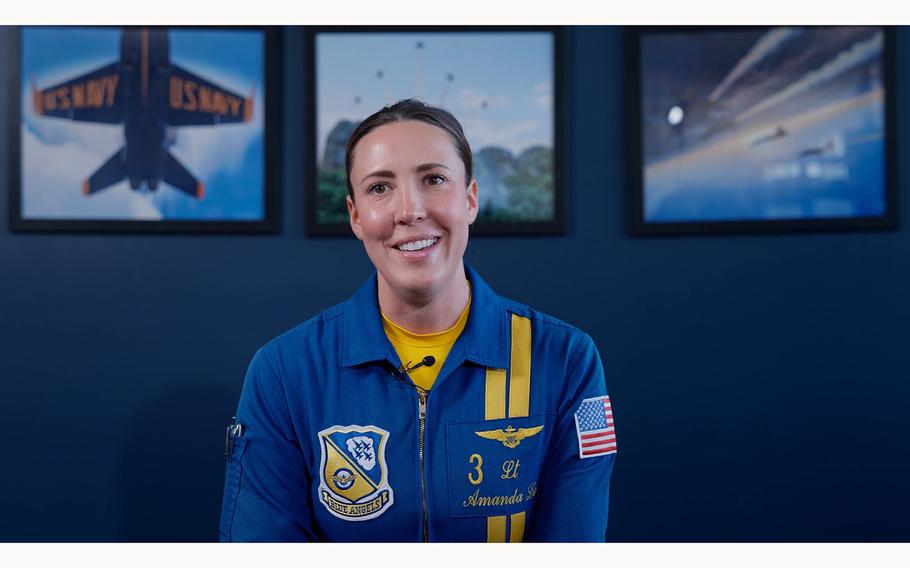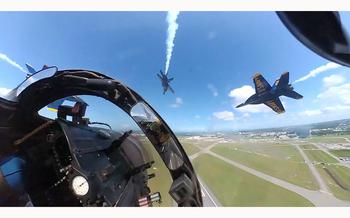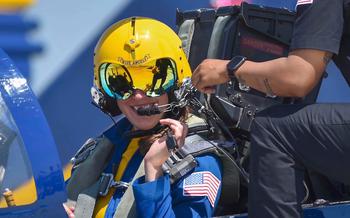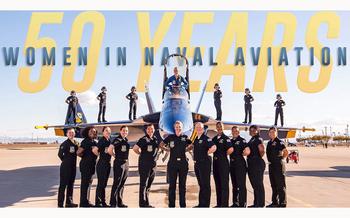
A video screen grab shows Lt. Cmdr. Amanda Lee, the first female Blue Angels F/A-18 Super Hornet demonstration pilot. (U.S. Navy)
TRAVERSE CITYMich. — The first female to fly in the U.S. Navy Blue Angels touched down at Cherry Capital Airport Thursday afternoon following a practice run over Grand Traverse Bay.
Dressed in a spotless blue and yellow flight suit, Lieutenant Commander Amanda Lee, 38, met with reporters on the tarmac at the U.S. Coast Guard Air Station just south of Parsons Road. Her polished blue F/A-18 Super Hornet stood just behind her.
“It’s absolutely beautiful up here!” she said after the practice flight. “It reminds me of flying over Lake Tahoe — the colors in the water. My husband even asked me if we might move here someday. What are the winters like?”
Inside the Coast Guard hangar, a volunteer made sure that Lee had her first taste of genuine Michigan cherry pie.
Lee is one of 17 officers who travel with the 160-person Blue Angels team. They perform high-speed acrobatics and precision maneuvers at 32 sites per year, said Navy Public Affairs specialist Cody Deccio.
During three winter months, they train and study, while also taking time to share knowledge with incoming pilots, he added.
Blue Angels legacy
This summer marks the 78th year for the Blue Angels, which was established in 1946 right after World War II with two primary missions: No. 1) To represent the men and women who currently serve in the Navy and Marine Corps; and No. 2) To showcase “the excitement, precision, and power of naval aviation both at home and abroad.”

A video screen grab shows aircraft with a Navy Blue Angels team doing loops. (U.S. Navy)
High-performance aerial performance teams like the Blue Angels and U.S. Air Force Thunderbirds are perennial favorites at the National Cherry Fest, drawing huge crowds from around the Midwest.
Local officials and air show fans were relieved in mid-April when a dispute between NCF and the airport authority was finally resolved following months of sometimes contentious negotiations.
The resulting three-year agreement allows the air show to continue with some modifications designed to accommodate the growing commercial airline service into TVC.
This year, the Blue Angels’ official air show performances are scheduled for June 29-30, from 1-4 p.m. on each day, according to officials at the National Cherry Festival.
Out of Minnesota
Lt. Commander Lee is not just the first female pilot in the Blue Angels, she’s also an enthusiastic advocate for the Navy and military service in general.
“The range of opportunities available to both men and women is truly amazing,” she said. “When I was younger, I was thinking about going into medicine. Now I’m flying jets with the Blue Angels — who would’ve guessed that would happen?
“I would strongly encourage young people to explore a future in the military. There’s so much to do and so much to learn.”
Born in Mounds View, Minnesota, near the Twin Cities, Lee was an avid athlete in high school, competing in soccer, ice hockey and swimming. While studying at the University of Minnesota Duluth, she enlisted in the Navy as an Aviation Electronic Technician.
In 2009, Lee was selected to train as a pilot through the “Seaman-to-Admiral” commissioning program. The following year, she attended the Naval Science Institute for officer training in Newport, Rhode Island, and simultaneously began her studies at Old Dominion University in Norfolk, Virginia, where she received a Bachelor of Science in biochemistry.

A video screen grab shows Navy Blue Angels pilot Lt. Cmdr. Amanda Lee in her flight gear. (U.S. Navy)
Lee joined the Blue Angels in September 2022. Since then, she has logged more than 1,800 flight hours and more than 225 carrier-arrested landings, which she called “a whole different experience than landing on the ground.”
On the tarmac, Lee was joined by Shelby Parker, a member of the Blue Angels support crew who happens to be from Michigan.
Both Parker and Lee said being a woman in the modern Navy is different than it was 30 years ago.
“We’ve treated the same as everybody else,” Parker said with a smile. “We’re part of the team.”
Lee made a point of thanking the women from the 1970s who blazed the way for women entering the military.
“I applaud what they did, and people like me benefit from their pioneering spirit.”
Beyond acrobatics
Not only does Lee fly a sleek F/A-18, she also teaches new pilots how to fly the aircraft, a skill she learned during many years of active duty service in various theaters.
After earning her pilot wings, Lee completed two combat deployments aboard the USS Harry Truman aircraft carrier supporting Operation Inherent Resolve against ISIS in Syria and Iraq, Operation Freedom Sentinel in Afghanistan and NATO Exercise Trident Junction in Norway.
Along the way, she served in a variety of officer roles both aboard ship and on land.
Full of smiles and optimism, Lee is not one to brag. However, a Navy spokesman noted separately that she has earned numerous medals and unit awards, including the Navy and Marine Corps Achievement Medal.

A video screen grab shows a slide celebrating the 50 years that women have been in naval aviation. Navy Blue Angels pilot Lt. Cmdr. Amanda Lee is in the cockpit of her aircraft in the center. (U.S. Navy)
Asked what it’s like to soar with the Blue Angels today, Lee said it’s “unlike anything else in flight. We really aim for perfection, even if that’s not entirely possible. We practice hard and learn together.”
Lee’s father is coming to Traverse City this week to watch her team perform. She also has a younger sister who served four years in the Navy.
Insider facts
Pilots in the Blue Angels team, who typically fly for 2-3 years, wear special headgear to protect their hearing, including noise-canceling devices. During flight, they communicate with each other — and the ground control station — via radio.
One of the biggest challenges the pilots face is learning where ground hazards are in each no place they visit.
The Grand Traverse Bay area is “like a ‘bowl” with its own unique topography, Lee said. And the presence of a large body of water next to hills affects the air currents.
To help prepare for a local air show, the pilots use a variety of tools, including 3D imaging software to highlight important obstacles that may present a hazard to low-flying, high-speed aircraft.
“We keep the program as standard as possible,” Lee explained. “That consistency helps keep us safe.”
Spokesman Deccio was quick to point out that pilots aren’t the only important members of the team. The Blue Angels also travels with a large contingent of maintenance and support specialists, all of whom are career-oriented enlisted Sailors or Marines who must pass a rigorous selection process after being recommended by their commanding officers.
Most of the support team arrive at an air show site in a Navy C-130J “Super Hercules” — a prop-driven cargo plane affectionately known as “Fat Albert.”
In addition to team members, it also carries about eight metal pallets full of specialized equipment and materials needed to keep the F/A-18s in good working condition.
The Blue Angels air show pilots started flying F/A-18 Super Hornets in 2021. Before that, the team performed in a wide variety of aircraft, including the F6 Hellcat, the F8 Bearcat, the F9 Panther and F-11 Tiger.
In the 1960s, they transitioned to the F-4 Phantom, the only two-seater flown in the famous delta formation. In 1974, they moved to the A-4 Skyhawk, a smaller and lighter aircraft with a tighter turning radius to enable “more dynamic flight demonstrations.”
(c)2024 The Record-Eagle (Traverse City, Mich.)
Visit The Record-Eagle
Distributed by Tribune Content Agency, LLC.